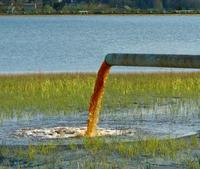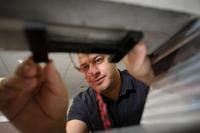-
Congress debates BioShield funding while medical schools debate bioterrorism training
Just as researchers urge medical schools across the United States to include bioterrorism preparedness courses in their curricula, Congress is debating whether to continue spending on Project Bioshield, an initiative launched in 2004 to incentivize otherwise unprofitable research on treatments for rare outbreaks or bioterror agents such as anthrax and botulinum toxin.
-
-
WIPP radiation leak investigation focuses on Los Alamos National Laboratory (LANL)
The U.S. Department of Energy’s (DOE) accident investigation team reviewing the leak at the Waste Isolation Pilot Plant (WIPP) in Carlsbad, New Mexico has turned its focus to the Los Alamos National Laboratory (LANL). Communications between LANL and EnergySolutions, the contractor which packaged LANL’s waste for shipment to WIPP, have revealed that EnergySolutions switched from using an inorganic clay-based absorbent in the storage drums to an organic wheat-based mixture. Scientists are now trying to determine whether the switch to the organic substance is to blame for the chemical reaction that led to the explosion.
-
-
Better tools for tracing food-borne illness to source
Research could make it easier for public health investigators to determine if a case of food poisoning is an isolated incident or part of a larger outbreak. The study focuses on a test called multi-locus variable number tandem repeats variable analysis (MLVA). The test, which is increasingly used in the detection and investigation of foodborne outbreaks, analyzes specific sequences of DNA (called loci) that change rapidly enough over time to distinguish outbreak strains from other circulating strains of the bacteria but not so rapidly that connections could be masked by changes arising during the course of an outbreak.
-
-
Congress may modify the amount, manner by which Project BioShield procurements are funded
In 2004, Congress passed the Project BioShield Act to provide the federal government with new authorities related to the development, procurement, and use of medical countermeasures against chemical, biological, radiological, and nuclear (CBRN) terrorism agents. Among other things, the authority allows the government to guarantee a market for CBRN medical countermeasures. Under this provision, the secretary of Health and Human Services (HHS) may obligate funds to purchase countermeasures that still need up to ten more years of development. Since 2004, HHS has obligated approximately $3.309 billion to guarantee a government market for countermeasures against anthrax, smallpox, botulism, radiation, and nerve agents. Another provision established a process through which the HHS secretary may temporarily allow the emergency use of countermeasures which lack Food and Drug Administration (FDA) approval. The 113th Congress may also consider modifying the amount and manner by which it funds Project BioShield procurements.
-
-
Sandia Labs-developed IED detector being transferred to the U.S. Army
Though IED detonations have declined in Afghanistan since a peak of more than 2,000 in the month of June 2012, Department of Defense reports indicated IEDs accounted for about 60 percent of U.S. casualties that year. Detecting improvised explosive devices in Afghanistan requires constant, intensive monitoring using rugged equipment. When Sandia researchers first demonstrated a modified miniature synthetic aperture radar (MiniSAR) system to do just that, some experts did not believe it. Those early doubts, however, are gone. Sandia’s Copperhead — a highly modified MiniSAR system mounted on unmanned aerial vehicles (UAVs) — has been uncovering IEDs in Afghanistan and Iraq since 2009. Now, Sandia is transferring the technology to the U.S. Army to support combat military personnel.
-
-
A farewell to (nuclear) arms: A novel technique could facilitate nuclear disarmament
A proven system for verifying that apparent nuclear weapons slated to be dismantled contained true warheads could provide a key step toward the further reduction of nuclear arms. The system would achieve this verification while safeguarding classified information that could lead to nuclear proliferation. Their novel approach, called a “zero-knowledge protocol,” would verify the presence of warheads without collecting any classified information at all.
-
-
Making nuclear power plants more resilient during earthquakes
Researchers in Finland are examining current nuclear power plants’ structure to see where improvements could be made to make them more resilient during earthquakes. Finland currently is building new nuclear power plants, and within ten years, the country expects to be getting 60 percent of its electricity from nuclear plants.
-
-
OPCW says Syria has completed handover of chemical weapons, but some are skeptical
Syria handed over the remaining 100 tons of toxic material to the Organization for the Prohibition of Chemical Weapons (OPCW) last Monday. The final consignment, publicly delayed, consisted of about 8 percent of the total 1,300 tons that the country is believed to have possessed. Despite the celebratory mood, many in the West look at the Syrian and OPCW announcements skeptically due to conflicting information.
-
-
Engineered enzymes to neutralize deadly effects of chemical weapons
Researchers are a step closer to creating a prophylactic drug that would neutralize the deadly effects of the chemical weapons used in Syria and elsewhere. The researchers are trying to engineer enzymes — called bioscavengers — so they work more efficiently against chemical weapons.
-
-
Using cosmic rays to peer inside Fukushima Daiichi reactors
Muon radiography (also called cosmic-ray radiography) uses secondary particles generated when cosmic rays collide with upper regions of Earth’s atmosphere to create images of the objects that the particles, called muons, penetrate. The process is analogous to an X-ray image, except muons are produced naturally and do not damage the materials they contact. Los Alamos National Laboratory the other day announced an impending partnership with Toshiba Corporation to use muon tomography safely to peer inside the cores of the Fukushima Daiichi reactors and create high-resolution images of the damaged nuclear material inside without ever breaching the cores themselves. The initiative could reduce the time required to clean up the disabled complex by at least a decade and greatly reduce radiation exposure to personnel working at the plant.
-
-
Synthetic aperture sonar to help in hunting sea mines
Mines are plentiful and easy to make. Some mines explode on contact. Others are more sophisticated, exploding or deploying torpedoes when their sensors detect certain acoustic, magnetic or pressure triggers. Some can destroy a ship in 200 feet of water. Since the Second World War, sea mines have damaged or sunk four times more U.S. Navy ships than all other means of attack combined, according to a Navy report on mine warfare. New sonar research could improve the Navy’s ability to find sea mines deep under water. The underlying technology, known as synthetic aperture sonar (SAS), uses advanced computing and signal processing power to create fine-resolution images of the seafloor based on reflected sound waves.
-
-
Chemical pollution of European waters is worse than anticipated

Until now environmental authorities and parts of the scientific community have considered toxic chemicals to be rather a local problem affecting only a few bodies of water. A new study, however, reveals for the first time on a large scale the ecological risks emanating from chemical toxicants for several thousands of European aquatic systems. Chemical toxicity represents an ecological threat to almost half of all European bodies of water, and in approximately 15 percent of cases, the biota in freshwater systems may even be subject to acute mortality.
-
-
Smart coating could make oil-spill cleanup faster and more efficient
In the wake of recent off-shore oil spills, and with the growing popularity of “fracking” — in which water is used to release oil and gas from shale – there is a need for easy, quick ways to separate oil and water. Now, scientists have developed coatings that can do just that.
-
-
Improved terahertz technology to benefit passenger screening, food inspection, MRIs
Researchers are developing new terahertz detectors based on carbon nanotubes that could lead to significant improvements in medical imaging, airport passenger screening, food inspection and other applications.Historically, the terahertz frequency range — which falls between the more conventional ranges used for electronics on one end and optics on another — has presented great promise along with vexing challenges for researchers.A major problem is that the photonic energy in the terahertz range is much smaller than for visible light, and currently there are nota lot of materials to absorb that light efficiently and convert it into an electronic signal.The researchers say there is a need to solve this technical problem to take advantage of the many beneficial applications for terahertz radiation.
-
-
Smart infrastructure sensors are powered by the pavement, bridges they monitor

As states look to improve its infrastructure — roads and bridges — researchers think they may have one solution. They are creating smart infrastructure sensors that are powered by the pavement and bridges they are designed to monitor. These small sensors will self-diagnose damage and mechanical failure in pavements and bridges.
-
More headlines
The long view
Keeping the Lights on with Nuclear Waste: Radiochemistry Transforms Nuclear Waste into Strategic Materials
How UNLV radiochemistry is pioneering the future of energy in the Southwest by salvaging strategic materials from nuclear dumps –and making it safe.
Model Predicts Long-Term Effects of Nuclear Waste on Underground Disposal Systems
The simulations matched results from an underground lab experiment in Switzerland, suggesting modeling could be used to validate the safety of nuclear disposal sites.
